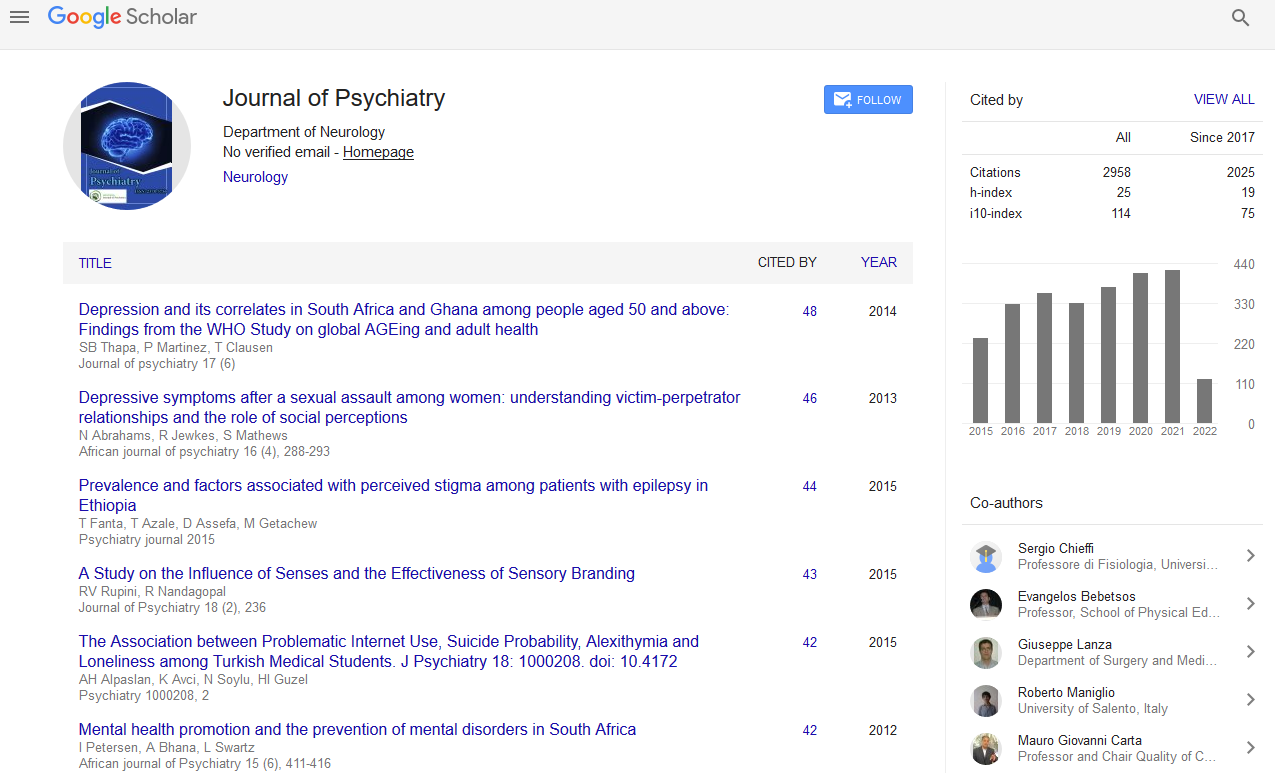PMC/PubMed Indexed Articles
Indexed In
- RefSeek
- Hamdard University
- EBSCO A-Z
- OCLC- WorldCat
- SWB online catalog
- Publons
- International committee of medical journals editors (ICMJE)
- Geneva Foundation for Medical Education and Research
Useful Links
Share This Page
Open Access Journals
- Agri and Aquaculture
- Biochemistry
- Bioinformatics & Systems Biology
- Business & Management
- Chemistry
- Clinical Sciences
- Engineering
- Food & Nutrition
- General Science
- Genetics & Molecular Biology
- Immunology & Microbiology
- Medical Sciences
- Neuroscience & Psychology
- Nursing & Health Care
- Pharmaceutical Sciences
Value Added Abstract - (2020) Volume 0, Issue 0
Investigating the Molecular Mechanism of Bipolar Disorder
Qiuwen Wang*Published: 16-Sep-2020
Abstract
Bipolar disorder (BD) is a complex neuropsychiatric disorder that is characterized by intermittent episodes of mania and depression. BD affects more than 1% population worldwide and has been ranked by the World Health Organization as a top disorder of morbidity and lost productivity. However, the pathogenesis of BD has remained enigmatic. This is mainly because genetic animal models based on identified susceptible genes have often failed to show core symptoms of BD, especially spontaneous mood cycling. The introduction of induced pluripotent stem cell (iPSC) technology has provided a new approach for research of BD pathogenesis. We have developed an iPSC model for human BD and investigated the cellular and molecular deficits of patient iPSC-derived hippocampal dentate gyrus-like neurons. Guided by patch-clamp recording analysis, we have observed hyperactive action-potential firing, which could be selectively reversed by lithium treatment. Both our iPSC-based RNA analysis and past pedigree research have implicated that dysfunction in some key signaling cascades might be crucial for the disease pathogenesis in a subpopulation of BD patients. We hypothesized that the behavioral abnormalities of patients and the comorbid metabolic abnormalities might share some identical molecular mechanism. Hence, we investigated the expression of insulin/synapse dually functioning genes in patient iPSC-derived neurons and their phenotypes in the behaviors of mice with these genes silenced in the hippocampus. By this means, we identified synaptotagmin-7 (Syt7) as a candidate risk factor for behavioral abnormalities. We then investigated Syt7 knockout (KO) mice and observed nocturnal manic-like and diurnal depressive-like behavioral fluctuations in a majority of these animals, which are analogous to the mood cycling symptoms of BD and could be treated by clinical drugs.

Biography:
Qiuwen Wang has been studying the molecular mechanisms involved in the pathogenesis of bipolar disorder. She has her expertise in Stem Cell Biology, Electrophysiology and Fluorescence Imaging. She is passionate on developing new therapies and drugs aimed at clinical treatment for bipolar disorder.

Speaker Publications:
1. Mertens J*, Wang QW*, Kim, Y., Yu, D.X., Pham, S., Yang, B., Zheng, Y., Diffenderfer, K.E., Zhang, J., Soltani, S., et al. (2015). “Differential responses to lithium in hyperexcitable neurons from patients with bipolar disorder”. Nature 527, 95-99.
2. Stern, S., Santos, R., Marchetto, M.C., Mendes, A.P.D., Rouleau, G.A., Biesmans, S., Wang, QW., Yao, J., Charnay, P., Bang, A.G., et al. (2018). “Neurons derived from patients with bipolar disorder divide into intrinsically different sub-populations of neurons, predicting the patients' responsiveness to lithium”. Molecular psychiatry 23, 1453-1465.
3. Wei Shen*, Wang QW* et al. “Synaptotagmin-7 is a key factor for bipolar-like behavioral abnormalities in mice”. PNAS, Accepted.
34th European Neurology Congress; Webinar-June 24-25, 2020.
Abstract Citation:
Qiuwen Wang, Investigating the molecular mechanism of bipolar disorder, Neurology Congress 2020, 34th European Neurology Congress Webinar- June 24-25, 2020.


